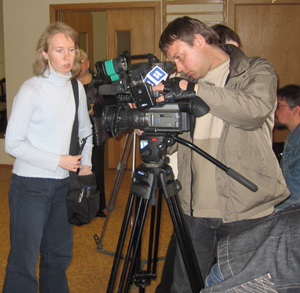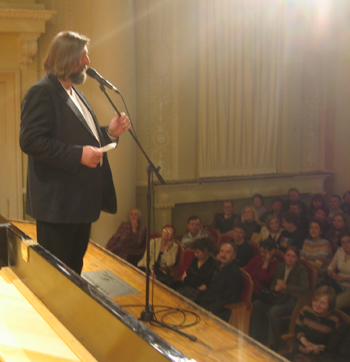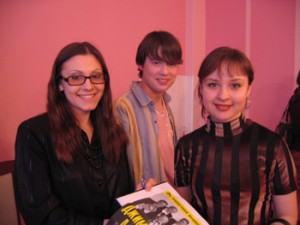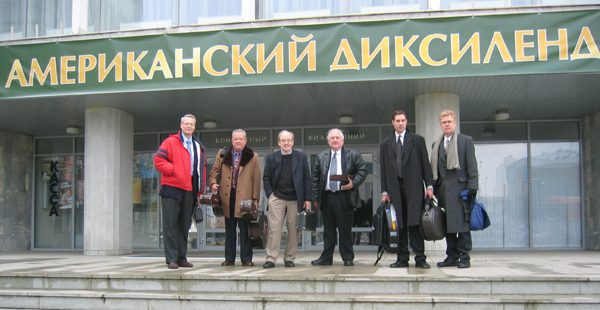
The JCJB at Philharmonic Hall in Perm, a 2-hour plane ride southeast of Moscow at the base of the Ural Mountains. The sign reads "Amerikanski Dixieland."
Our American Jazz Creates a Russian Sensation
A rattle-trap streetcar rolls along
in what New Orleans would be called
the “Neutral Ground.” “Wow! Look at
that streetcar,” I exclaim, for the
thing is sided with corrugated tin.
It’s obvious that this streetcar and
others we passed have been in
service for quite a tour of duty,
but they do their jobs—packed with
locals, they roll along smoothly.
The driver of our small bus grinds
the gears, revving the old
four-cylinder engine. Howard Elkins,
with his typical wry smile comments,
“Sounds like my old Dodge truck; it
was a 1950.”
So far, the smaller Russian cities
remind me of my youthful forays into
Mexico: dusty streets, slap-dash
construction and unfinished walls
with the rebar sticking up as though
the upper floors were planned but
the money ran out, curbs here and
there for 40 yards and then no
curbs, and then the occasional grand
building that looks like it was
built with great care and artistry.
The bus shudders and strains around
one final hard turn and enters the
hotel parking lot, jolts to a stop
and the six Americans and one
Russian tumble out, grappling with
the luggage. The local sponsors of
the concert are really trying to
maneuver it but we grab our own
stuff and swarm the desk. It’s a
four-star hotel.
In an hour we’re rolling again to
the Perm Concert Hall. That’s the
name of this burg: Perm, Russia.
We’re escorted into a formal room where seven chairs are lined up behind a long table; each man’s place is indicated by a bottle of water and a glass. Opposite all this is a row of reporters with pencils and questions ready. The questions are the usual ones: “Why do you play only older jazz? What is different about your approach? Do you play vintage instruments?”
This continues for 45 minutes. “This
way, please,” and we get up, heading
off again down corridors and into
another formal room where a table is
beautifully set with appetizers. And
on comes the Russian food—lots of
Russian food!
Out to the stage. The great Russian
pianist Valeri Grohovski is our
spokesman. He has gained the deep
respect of us all, for not only is
he a very special virtuoso, he is
also charming, intelligent and
articulate in both Russian and
English.
He stands on the boards—bearded,
long hair, handsome, his blue eyes
flashing. His resonant baritone
voice mumbles and babbles out the
Russian, and the audience, packed in
as tight as they will go, leans
forward.
This will be a concert like no
other,” he begins, and the
mood-setting power of his words and
presence takes up a full five
minutes. Still talking, he flows on
over to one of the two nine-foot
grand pianos. He begins to swing the
Charlie Shavers piece, “Undecided.”
At about one-half chorus intervals
we filter in, each man’s appearance
greeted by thunderous applause. The
piece winds and builds as solos are
passed around, and the final
ensembles come on and howl toward
the ending. The band digs in and
drives harder. I work up to a high C
and let them do the rest as we stomp
two extra bars. The last measure
towards the 3rd beat—I rip to an E,
and a cymbal crashes short on the
4th beat. Those endings—I think of a
man running for all his worth and
driving through the doors of a
subway car just as they slam closed!
There are about two seconds of
silence—the audience seems
stunned—before applause explodes in
our faces!
Valeri leaves the stage and we begin
the magic of the jazz band that has
driven, fascinated, delighted, and
to a great degree made my life
complete, while at the same time
frustrated me—this for 50 years. The
crowd is right there with every
note. I look into the eyes of those
on the first five rows, and there is
this passion for music.
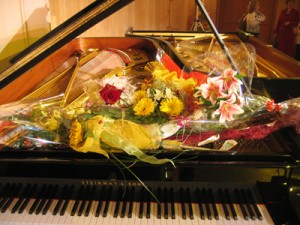
Flowers from the audience after the concert in Perm. All of the Russian audiences gave us flowers at the conclusion of the concerts.
In the second half Valeri comes
back. We go after it with two
pianos. The set spins by towards a
grand finale, “The Raggle Taggle,” a
minor-key up-tempo blues by the
obscure San Antonio
bandleader/drummer “Boots” Douglas.
Our version is 4 times as long as
Boots’ with an added section where I
and then Ron Hockett play up and
down a C minor chord with tom-toms.
The tom-toms continue. I come back
for a little C minor run, a hint of
a famous Russian melody. He answers.
We go back and forth like this for a
while, then on a nod, the full
rhythm section is in. We’ve worked
this out. “Midnight in Moscow,” a
song familiar to all Russians as
“Moscow Nights,” spills out and
fills the hall.
The high voltage in the air jumps up
another 50%. We modulate to D minor
for another chorus and stretch the
ending of the piece.
The audience is on its feet cheering
on and on. Pretty young Russian
girls bring us bouquets of flowers,
one after the other, as we take
bows. The audience starts applauding
in a rhythm: whop! whop! whop! whop!
There are bows and bows! Then an
encore. We play Armstrong’s “Swing
That Music.” They’re standing again
and clapping in unison.
And then we’re off. Security closes
us off, but a number of autograph
seekers figure out a way backstage.
Finally it’s over and we’re hustled
back into the formal dining room
where another full meal is brought
on. Here come the vodka toasts!
I reflect on a few things. One must
leave town, for a prophet is not
praised in his home town. For us,
for Americans, some things about our
culture are just there, have always
been there. Some of us know about
and can get into the subtleties in
the heads of Beiderbecke or Bessie
Smith or hundreds of others and take
such delight in every nuance, but
most can not or do not. I am halfway
around the world playing for the
Russians. They have barely ever
heard it before. They have “fresh
eyes.” And here they are “inside”
the music, right with us.
And I am so American down to my
toenails with that Getzen cornet in
my hand. Sandy Sandberg and Doc
Severinsen showed up with a
prototype Getzen in 1963. “Just try
it. If you like it, it’s yours.”
Finally, after all the years and all
the cornets made by famous makers:
Courtois from France, the famous
Bach Stradivarius, Yamaha this and
that, the great Conn Victor, the
King with its sterling silver bell,
and so many others, that simple
Getzen made in a little country town
in Wisconsin is still the best.
I think of Merle Heirman, the
designer of the cornet—a pleasant,
humble man with a leather apron—a
workman and craftsman. He was like
me, I think. He learned on the
job—was a factory man, a soldering
man and when the time came he said,
“Let me try. I think I can make a
great trumpet.” He put one together
and it became the “Severinsen
model.” And then he said, “Now I
want to build the greatest cornet in
history.” It was all the result of a
lifetime of thinking about it and
dreaming about it.
The Russian trumpet players want to
see it. “Where did you get it?
American made?”
A symphony conductor is there from
Moscow. “How did you learn that
music?” he looks at me curiously.
“Why? How?”
How do I answer him? There really
isn’t a good answer. He repeats the
questions. He’s very friendly,
smiling. “Did you learn at a
conservatory?”
“Oh no! Just learned by doing it all
my life, and I’m still learning,” I
finally say. “And I listened to the
masters. Bix and Louis mostly.”
The characteristics of the concerts
are mostly the same. Sold-out houses
with extra chairs in the aisles and
people standing along the walls.


